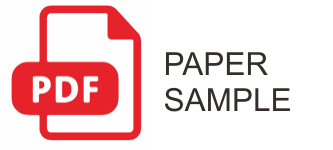REVIEWER GUIDELINES
Guidelines for Reviewers
Responsibility of Peer Reviewer
A peer reviewer is responsible for critiquing by reading and evaluating manuscripts in their area of expertise and then providing constructive advice and candid feedback to the author of the submitted article. Peer reviewers discuss the strengths and weaknesses of the article, how to improve the article's strength and quality, and evaluate the manuscript's relevance and authenticity.
Before reviewing, please take the following into account:
- Is the article requested for review within your area of expertise? Please inform the editor as soon as possible if you receive a script that covers topics outside of your area of expertise. Please suggest a replacement reviewer.
- Do you have time to review this document? The evaluation process must be concluded within four weeks. Notify the editor as soon as possible if you agree and require a longer period, or suggest an alternative reviewer.
- Is there the possibility of a conflict of interest? In the meantime, conflicts of interest do not disqualify you as a reviewer; however, you must disclose all conflicts of interest to the editor prior to reviewing. If you have any questions regarding possible conflicts of interest, please contact the editorial office.
Content of the Article
In order to determine the originality and suitability for the journal, are there any elements of plagiarism over 24% of this paper field? Quick literature search can use certain tools such as Scopus to see if there are similarities from other parts.
- If the study had been previously done by other authors, it is still eligible for publication?
- Is the article is fairly new, fairly deep, and interesting to be published?
- Does it contribute to knowledge?
- Does the article adhere to the standards of the journal?
- Scope - Is the article in line with the objectives and scope of the journal?
Review Process
When reviewing the article, please consider the following:
- Title: Is the title clearly illustrating the article?
- Abstract:
- Does the abstract reflect the contents of the article?
- Does the abstract contains purpose, research method, findings, and implication in paper?
- Introduction:
- Does the introduction describe the accuracy of matters submitted by the author and clearly state the problem being considered? Typically, the introduction should summarize the context of the relevant research, and explain the findings of the research or other findings, if any, offered for
- Why is this study being conducted? The article should begin with an introductory section that explains the paper's objective, motivation, research methodology, and findings. Introductions should be relatively nontechnical, nevertheless clear enough for a knowledgeable reader to comprehend the manuscript's contribution. The "introduction" in the manuscript should describe the reasons for conducting the research to contribute to the literature, theories, and/ or methodological issues.
- Literature Review and Hypothesis Development
- Does it investigate the identified and resolved gaps in greater depth? Considering the flow of all the ideas, it is essential that they are interconnected, well-crafted, and thoroughly developed. Perhaps the author (s) should consider supporting the research questions with theory. Consequently, theory will support the research questions, while the research questions will serve as the foundation for hypotheses related to the research objective.
- Does it support by the update and reputable article such as Scopus and Sinta? This journal have a rule that the article should use refers international reference sources (at least 40 percent of Scopus) and an index by SINTA (Indonesia)
- Research Methodology
- Does the author accurately describe how the data is collected?
- Is the exposure design suitable for the answer to the question?
- Is there a decent enough information for you to imitate the research?
- Does the article identify following procedures?
- Are there any new methods? If there is a new method, does the author explain it in details?
- Is there any appropriate sampling?
- Have the tools and materials used been adequately explained?
- Does the article exposure describe what type of data is recorded; right in describing the measurement?
- Result and Discussion
- It is essential that the author reports the results in sufficient detail so that the reader will be able to see which statistical analysis they conducted and why, and they will then be able to justify their conclusions.
- The “Result and Discussion” part, describes the rationale behind the results, answering the question, “How can the result be so?”
- There are both theories and evidence-based on the results of the study, resulting in relevance to the research problem. It goes deeper than just explaining the figures and deals with this deep analysis to close the gap that it is trying to fill.
- In addition, the authors must explain how their findings differ from those of earlier research.
- Finally, the discussion of results must demonstrate the practical implications of the research findings, but the authors should provide precisely.
- Conclusion and Suggestion
- Conclusion: The author summarises the research's objectives and findings concisely and findings. The conclusion should summarize the paper's main points, but it should not repeat the abstract.
- Contribution: Authors should provide a concise summary of the contribution result, including contribution to the literature, methodological issues, theory, and/ or practical implications.
- Limitations include criticism of the paper's theoretical foundation, methodology, and measurement, and/ or the inaccuracy between the hypothesis and the findings. Moreover, limitations indicate what other scientists should do in the future and provide justifications (referring to scientific articles).
Tables and Pictures:
Is it compatible with the referenced explanation by displaying data that is simple to interpret and comprehend for the readers?
Writing Styles
- Authors must be critical mostly to the literature systematic review of the issues, which is relevant to the field of study.
- Reviews should be focused on a single topic.
- All exposure should be in English/ Indonesian and written in a good and coherent grammar/ “Ejaan Yang Disempurnakan (EYD)”.
- Easy to understand
- Interesting to read
Originality Research [if possible]
- The original data and testing, it must present data that offers a new approach to improve systems, processes, and precision of the tools which are used.
- Research policy and observational analysis, it should clarify the feasibility, effectiveness, and implementation on the research results. It is not limited to the topic of financial accounting, sustainability accounting, audit and fraud, islamic accounting, corporate governance, management accounting, and taxation.
- In Practice (case study), The paper should explain the situation regarding the future challenges in financial accounting, sustainability accounting, audit and fraud, islamic accounting, corporate governance, management accounting, and taxation.
Final Review
- All review results submitted by reviewers are kept confidential.
- Inform the editor if you wish to discuss the article with a colleague.
- Do not directly contact the author.
- Ethical concerns:
- If you suspect that the article is largely plagiarised from other authors, please provide the editor with specifics.
- Fraud: It is extremely difficult to detect a fraud category; however, if you suspect that the results in the article are not accurate, please notify the editor.
Complete "The Review" by the deadline and submit it to the editorial office. Your recommendation for the article will be taken into account when the editor makes a final decision, and your candid feedback is greatly valued.
When writing a comment, please indicate which portions are intended for the editor and which portions can be returned to the author.
Please do not hesitate to contact the editorial office if you have any questions or encounter any issues.












